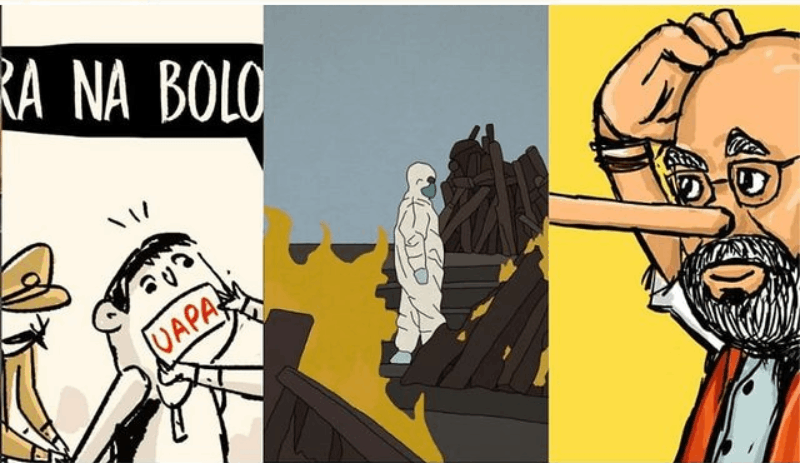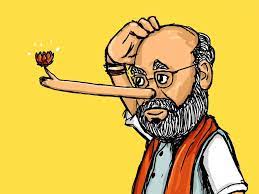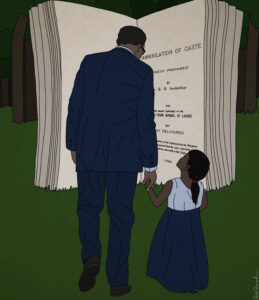The age of illustrative digital dissent

Digital political illustrations have become the voice of the masses in an increasingly censored media (Image credit: Aroop Mishra, Kamran Akhter, and Siddhesh Gautam)
It is April 2021, the second wave of Covid-19 has hit India like a tonne of bricks, shattering the entire healthcare system. People are dying left and right, the politicians who are supposed to lead the country away from this catastrophe are missing. Hundreds of thousands lose their lives in a matter of days as cremation and burial grounds were overcrowded with bodies of relatives, friends and neighbours who failed to find oxygen and hospital beds. While India suffered its worst-ever healthcare crisis, the Prime Minister and his entire team was busy in canvassing for votes in crowded rallies with leaders and their flock ignoring all preventive measures like masks or social distancing. The ironic tragedy that the mainstream media chose to ignore or underplay was however captured in several illustrations by artists like; Aroop Mishra, Kamran Akhter (Chhabikar), Siddhesh Gautam (bakeryprasad), Rachita Taneja (Sanitarypanels), Smish (Smishdesigns), Harshveer Jain (storysellercomics), Satish Acharya, G. Balakrihnan, Manjul Toons etc.

The illustration by Aroop Mishra on India’s second wave
Over the past few years, along with the explosion of a variety of social media platforms in India, digital political cartoons have also blossomed, bringing to life numerous illustrators whose creativity and sharp satire was perhaps becoming too close to reality for the mainstream media that has turned meek ever since the Narendra Modi government took charge in 2014. “I have been making digital art for almost five years, but I did not indulge in social and political issues,” says Kamran Akhter, a visual artist who goes by the name ‘Chhabikar’ on social media platform Instagram. “Slowly the nature of my work shifted towards the environmental issues and soon I started looking at more social issues, but it wasn’t until December 2019 when our Home Minister was explaining the chronology of CAA and NRC, that I finally created my first political/protest artwork,” Akhter tells Media India Group.

Kamran Akhter’s first political illustration during the Anti-CAA protests
The extensive, nationwide protests against Citizenship Amendment Act in 2019 proved to the turning point for many illustrators to go digital as the only way they could communicate what they wanted to a wider audience was through their art. “Making art is a process of letting your thoughts out,” says Akhter, adding, “when someone gets angry, they vent their anger by shouting. The same thing applies to the artist and his art. I feel relieved speaking my thoughts out. When you have to talk on a sensitive topic, it is really challenging to express your views with the same sensitivity, art on the other hand does the job easily.”
The real challenge for a political illustrator is to see make the situation lighter, fill it with humour, empathy and solidarity, adds Akhter.
The anti-CAA protests were some of the biggest demonstrations seen since the independence, giving way to a whole new generation of artists to come into spotlight to help portray the emotions of the masses through their art.
“As the digital media and platforms were already attracting new artists and designers, it was only a matter of time for the political art and protest art to also shift and explore the virtual media.” says Siddhesh Gautam, an artist, visual designer, storyteller, though most would perhaps know him as ‘bakeryprasad’ on Instagram. “The anti-CAA was a big protest and it attracted a lot of artists, poets, writers, musicians and so on. People wanted to express and contribute from all over the country which they did. The artworks that were trending in social media platforms were also physically produced at various protest sites as well. The sites were art exhibitions of their own kind having a common theme; equality, liberty, justice, freedom and fraternity,” Gautam tells Media India Group.

Illustrations by bakeryprasad mostly revolves arounds the ills of caste system, transgender rights, CAA, and environmental concerns
“It is like you are much aware of your surroundings, your economic status, your privilege etc.,” says Aroop Mishra, a visual artist and illustrator, “You realise commodities which might come easy to you because you belong to certain caste or community can be hard to arrange for someone coming from a different background. You start noticing these inequalities, the faults in your own society which you have never thought about it before. And now when you find these new changes in your surroundings, you are forced to make a comment on it through your drawings.”
Mishra has covered topics ranging from nationalism and lynching to unemployment and poverty. “I try not to involve much into ‘neta’ politics but other than that, I have drawn on every major issue which are crippling our society,” Mishra tells Media India Group.
“I think all issues that seek social justice, be it human rights, women’s rights, issues of workers and laborers, protection of marginalised communities, and their livelihood are connected to each other,” says Akhter. “An artist cannot choose to stand for one and not for another. I may not feel outraged on a personal level for each and every topic, but an artist must understand that each and every issue deserves the same attention, and no oppression is lesser than the another,” he adds.
True to his word, Akhter has a wide and diverse array of illustrations to show, where he has covered everything on the Indian political spectrum. From anti-CAA to the ongoing farmers’ protest. “My purpose in making art is to show my solidarity with the oppressed,” adds Akhter, “and giving voice to those who need it. I use my art, to tell the truth, give an opinion that gets lost in the media. For me, making art is a learning experience to understand an issue and through my art, I try to share what I have learned in the process.”
Though making political art can be polarising. Political illustrations depicting sensitive topics usually get a lot of attention but at the same time, it polarises your audience into two groups. “Group A will love your work and will come around and pat you on your back for speaking about the sensitive topic but there will be another group, Group B which will hate you for hurting their opinions and feelings,” says Mishra. “So, the best you can do is create an art which somehow depicts the Group B respectfully or at least put their feelings in consideration,” he adds.
But the artists say that this ‘balance’ is the most difficult thing to achieve, because no matter what, politics is something that will always polarise one section of the society or the other, and hence political drawings will always have a fanbase and a group of people who will always despise it with a passion.
With each work, Gautam’s only goal is to not just create superficially beautiful objects but to expand the viewers mind and demolish their preconceived assumptions. And for the long run, he wants to witness and contribute to the Bahujan Art Movement, or the movement by the underprivileged communities like the Dalits long considered untouchables in India, that could lead to an Indian art renaissance and cultural revolution.
Informing the masses about serious issues in the simplest of ways is the biggest goal of his illustrations, says Mishra. “I sincerely hope when people look at my cartoons or illustrations, they get a simplified understanding of the issue which I have drawn about and later force themselves to go read about it,” he says.
India ranks very poorly on the freedom of speech index and media freedom in the world and its score in both has declined sharply since the arrival of Modi as Prime Minister in 2014, according to the ‘2021 freedom of press index’ released by RSF, which is a two spot drop from 2013. In a country where the artists, comedians, journalists and students are constantly at risk of getting the ire of the authorities and ‘trolls’, it is a difficult task being a political artist. “I haven’t faced any problem from the authorities but rather been trolled a lot,” says Akhter, adding “but I have accepted the fact that there are people who get offended by the truth and that’s what art must do. Offend the oppressor and comfort the oppressed.”
But to make a thought-provoking art piece, the artist must have a well-informed understanding of the subject and be immersed in news all the time, to keep up with the current happenings of the world for the illustrations to be meaningful.
“It is a bit hard for sure, you have to surround yourself with news whenever possible,” says Mishra, “but at the same time, you feel a certain responsibility of understanding what’s happening around you and comment on it in whatever way possible. For me, the medium is drawing but other people do it by talking or writing about it.”
Mishra likes to read all the news he can consume in the morning, before choosing a topic to work on. “It is not easy, but it can be managed,” he says.
News though can take an immense toll on people constantly consuming it without break, “Sometimes the news is too triggering,” says Akhter, “but it is the only way for any artist to be aware of the information that is needed for any artwork. However, I try to read less news and read more books to understand a topic.”
Political illustrations have risen up in a time period of India when the smallest of disagreement with the authorities can land people in deep trouble, so it is natural that many have started seeing it as the best form of dissent.
In December of last year, Rachita Taneja, the creator of sanitary panels, was issued a contempt notice by the supreme court for uploading two comic strips on her social media, being critical of the apex court. But this is not the only time when illustrators/cartoonists have gotten in trouble with the authorities, recently Manjul, a political cartoonist, who goes by the name Manjultoons on twitter, received an email from twitter, informing him that the ‘Indian law enforcement’ believe that his account ‘violates the laws of India’, without specifying the cartoons or the laws that those illustrations violate.
“Dissent is one of the many expressions that a creative professional express, experiences and reflects upon,” adds Gautam, “Since it is a strong expression in itself, it gets all the limelight, and many other emotions and expressions are either cornered or murdered due to the pressure of the society and its expectations. In the current times, when censorship and surveillance is at its peak, it’s dangerous to be even be considered as the artistic voice of dissent. But due to the very same reason, it’s our responsibility to let dissent overpower the other expressions for a while, till it gets better. I hope that things will get better, and we could nurture our other expressions and be just the artistic voice of India,” says Gautam.









